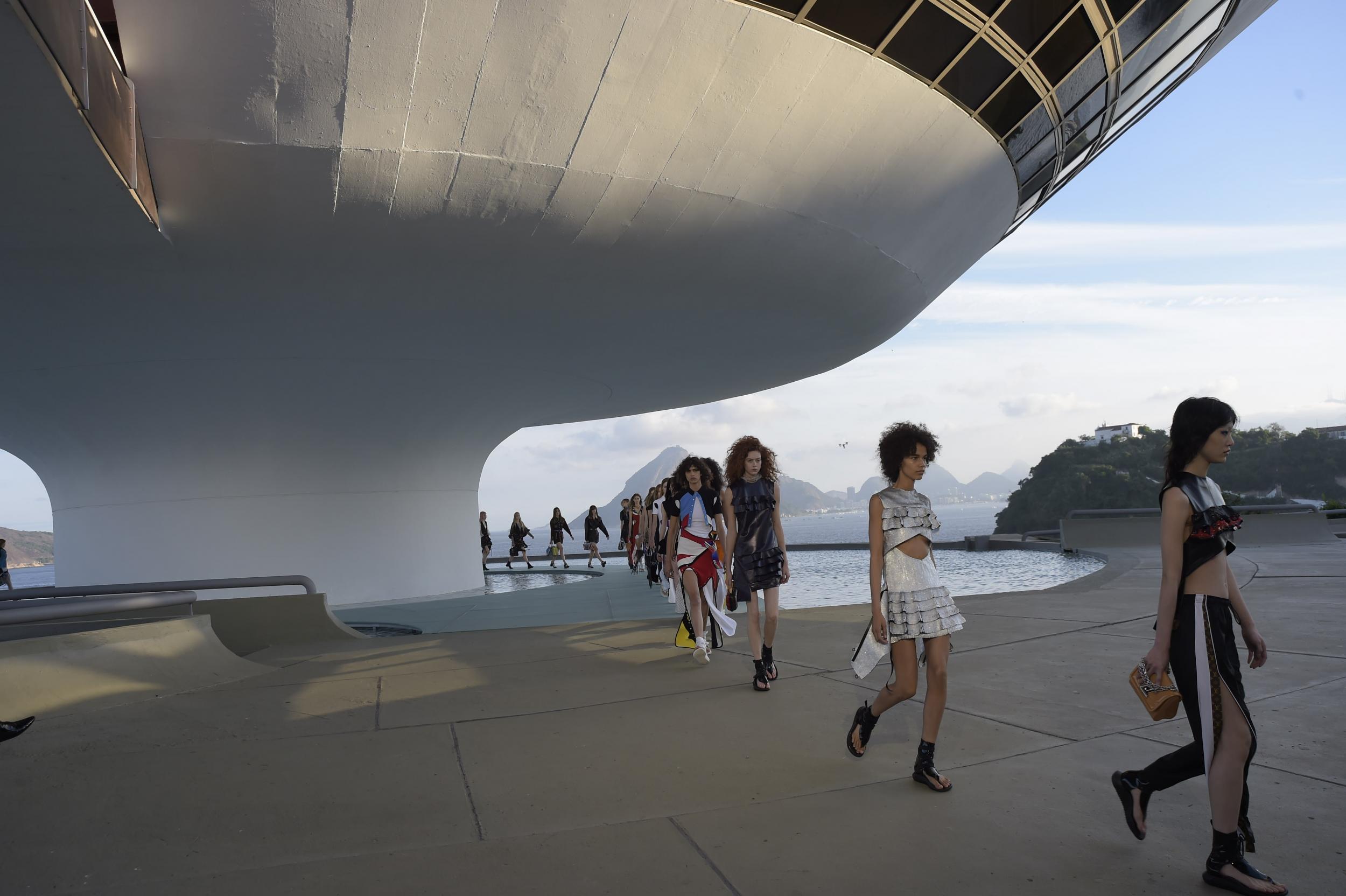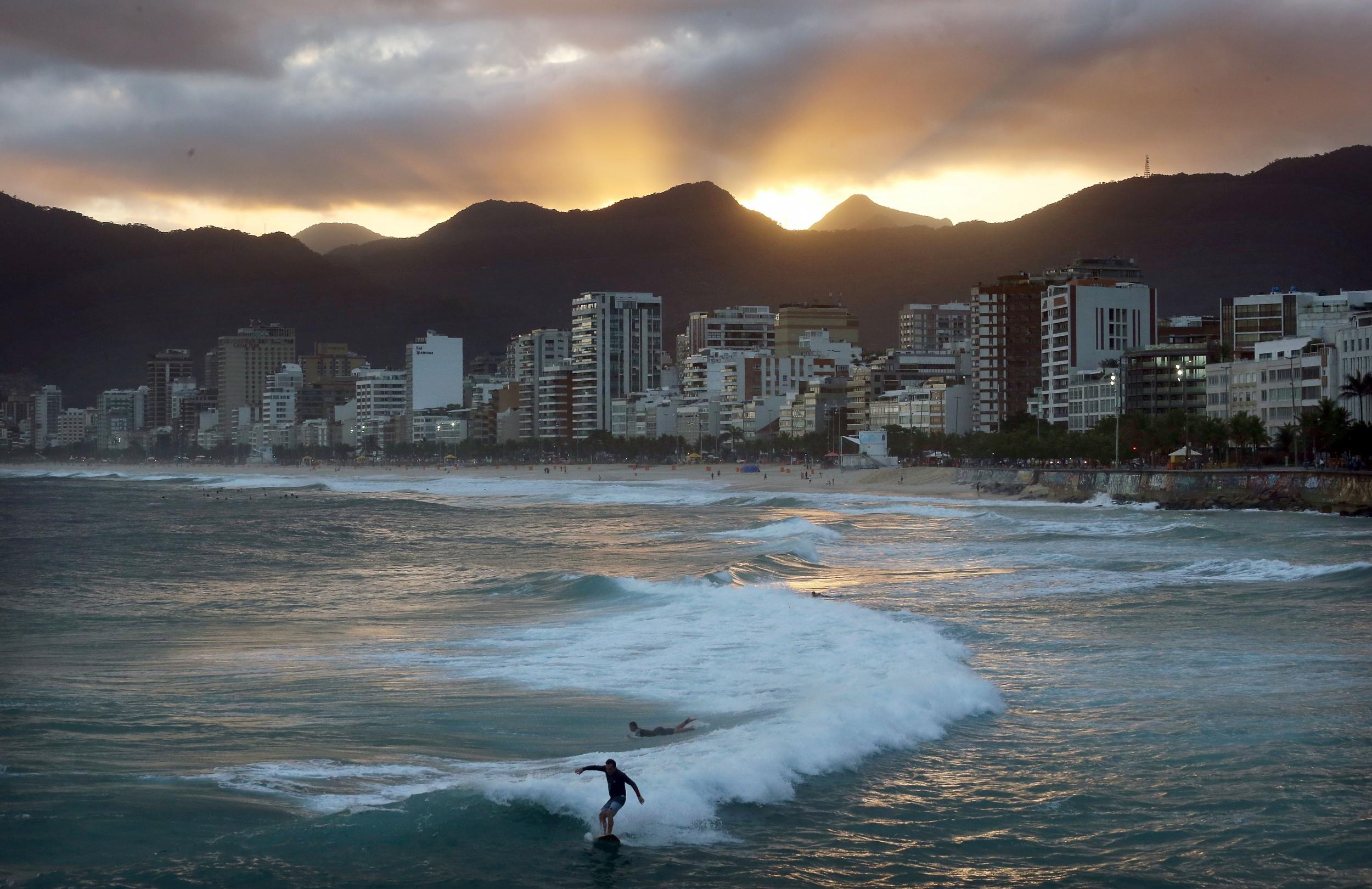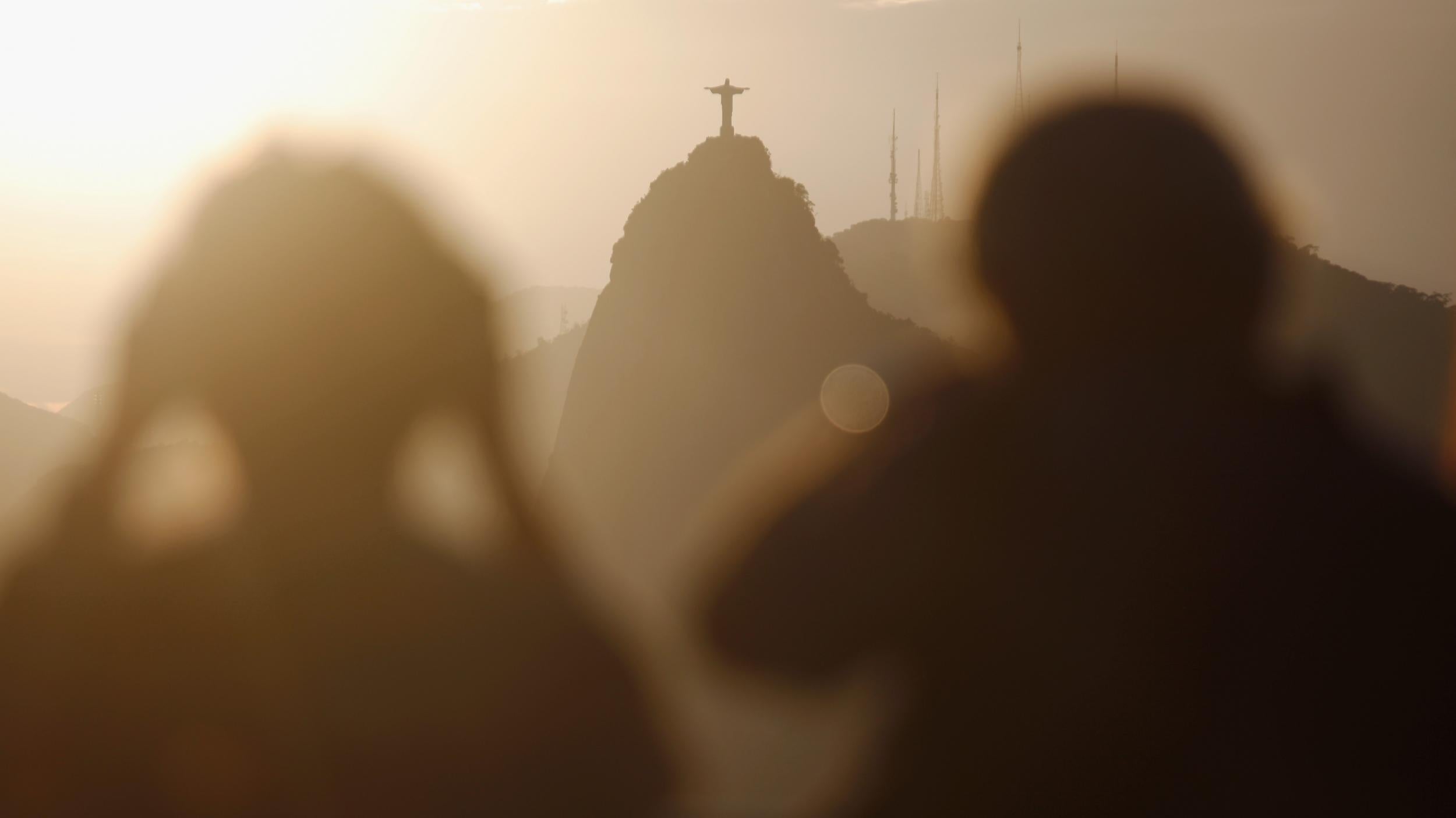The Full Brazilian: Louis Vuitton comes to Rio, but with economic collapse and pandemics rife, is the girl from Ipanema still luxury's ideal customer?
Louis Vuitton have opted to stage their latest Cruise fashion show in Rio de Janeiro - a decision announced last October, before presidential impeachment, the Zika virus and a collapsing currency plunged Brazil into turmoil. It forms a fascinating backdrop to the manoeuvres of a multi-billion pound corporation, says Alexander Fury
Your support helps us to tell the story
From reproductive rights to climate change to Big Tech, The Independent is on the ground when the story is developing. Whether it's investigating the financials of Elon Musk's pro-Trump PAC or producing our latest documentary, 'The A Word', which shines a light on the American women fighting for reproductive rights, we know how important it is to parse out the facts from the messaging.
At such a critical moment in US history, we need reporters on the ground. Your donation allows us to keep sending journalists to speak to both sides of the story.
The Independent is trusted by Americans across the entire political spectrum. And unlike many other quality news outlets, we choose not to lock Americans out of our reporting and analysis with paywalls. We believe quality journalism should be available to everyone, paid for by those who can afford it.
Your support makes all the difference.
In the past three or so years, a ritual has evolved in the fashion world. Rather than the regular, biannual crop of catwalk shows scattered between the traditional capitals of New York, London, Milan and Paris, designers have been hi-octane staging shows in far-flung locales. Seoul, anyone? How about Havana, Dubai, Palm Springs - frequently within days of each other.
In itself, that isn’t new: the idea of, say, re-staging a Paris show in Tokyo or Beijing to chime with an exhibition or a shop opening is a good way to guarantee native press, and to give heavy-spending local clients a bit of excitement, hopefully to entice them to part with a bunch of cash for a bunch of clothes. Designers have been doing it regularly since the fifties.
The latest crop of shows is different. Firstly, they’re showing new clothes, not old. The collections are dubbed either Cruise or Resort, but a more accurate name is pre-Spring, as they’re collections designed to arrive in store before the spring/summer collection hits, normally around November. And they have created a new fashion show schedule, taking place between the start of May (around the time the Met Gala is staged) through to early June (when menswear begins). And the clothes themselves, far from being a European fashion ideal exported to an exotic locale, generally reflect the place, and sometimes the space, in which they are shown.
Thus the fact that on Saturday night, Nicolas Ghesquière of Louis Vuitton presented his latest Cruise 2017 collection in a globulous white Oscar Niemeyer-designed building, the Niterói Contemporary Art Museum (Museu de Arte Contemporânea in Portuguese, abbreviated most often to to MAC), crouched on the coast of Rio de Janeiro. The backdrop suited the clothes, swirled with pattern and colour in a style clearly influenced by Niemeyer’s quintessentially Brazilian Modernism. Some of the garments had strips of ruffles, like a valance, plastered across the chest, which to me mimicked the slaloming walkways and overhanging façades of Niemeyer.

Much of the clothing was influenced by scuba-diving gear. It felt familiar - it’s something you see everywhere in Rio, where the beach is never far away, and it is something Ghesquière has done before. During his tenure at Balenciaga, he created an influential collection of tight dresses that clung like wetsuits, even to dry bodies, with ergonomic seaming. The moniker "body-conscious" - an eighties term denoting the sort of provocatively taut clothes worn by women on Azzedine Alaïa catwalks and in Robert Palmer videos - was attached to that Ghesquière collection. He echoed it today. Niemeyer once compared the swerves and curves of his architecture to the bodies of women, which seems to have got to Ghesquière. “There’s a lot of tropicalism, and urbanity too,” said Ghesquière in backstage interview, which actually took place on a scarlet walkway, lolling out of the Niterói MAC like a lazy tongue, along which the 47 Vuitton models had earlier descended.
“Here in Brazil, especially in Rio, the city and nature are really close to each other,” Ghesquière continued. “It’s really inspiring. I love urban clothes, clothes that women wear in the city.” Of course, women in Rio wear clothes different to most other cities - swimming costumes, which formed the basis for the collections’ strongest sequence, opening outfits seemingly constructed of neoprene (actually, it was jersey) that resembled layered cut-out swimsuits with dangling skirts and footwear that cross-bred booties with Haviana flip-flops. Other footwear resembled diving boots with Vuitton branding flashed across in airbrushed lettering, Point Break style; paper-thin suede and leather dresses were carved into two-pieces with inlaid bikini brassieres; footballers were printed on others, taken from the work of Brazilian artist Aldemir Martins, itself intended as an ode to Brazil. “I’m obsessed with sports clothes, movement, new casual,” said Ghesquière. “What better place than Rio to show these ideas?”
That, indeed, is the question. The forthcoming Olympics (set to begin on 5th August) undoubtedly underscores Ghesquière’s key themes. And Niemeyer’s architecture is right up his proverbial Rue - indeed, the Niterói building looks remarkably like the John Lautner-designed Bob and Dolores Hope Estate in Palm Springs, where Ghesquière showed his collection last May. It has the same curvaceous yet modern lines, the same hilltop ambience, a pool of water reflecting many of the same members of the fashion press (mixed with about 150 Brazilian celebrities and a healthy number of clients from the country). The same sense of retro-futuristic fantasy. There was also a sense of déjà vu.
But Rio de Janeiro is a very different place to show than California. The climate - cultural, rather than the balmy heat - is entirely separate, especially today. The president of Brazil, Dilma Rousseff, was suspended from office earlier this month, in the process of a will-she won’t-she impeachment which some consider justice served, and others tantamount to a right-wing coup. Rousseff is accused of budgetary manipulation, of violation of laws on fiscal responsibility relating to the state gas and oil firm Petrobras. More than half the members of congress are implicated. The use of Olympics funds are also being investigated in a wide-ranging corruption probe. Simultaneously, the Zika endemic has caused panic. While tourism remains relatively unaffected, on Friday more than 100 doctors and professors across the world signed an open letter to World Health Organisation Director-General Margaret Chan calling for the Rio games to be postponed or moved ”in the name of public health" due to the widening outbreak. A week ago, the US swim team relocated their pre-olympics training camp from Puerto Rico to Atlanta, in response to medical concerns.

The first is more immediately relevant to Vuitton than the second, where mosquito repellant is a quick fix. Brazil’s financial crisis isn’t so easily remedied, especially for a luxury label reliant on ready cash and a willingness to spend it. Vuitton are the first brand to stage a show in Brazil - a bold move. It was also one announced last October: before Rousseff’s impeachment; prior to the resignation of Brazilian finance minister Joaquim Levy in December that saw the real, Brazil’s currency, drop 2.7 per cent; before Brazil’s credit status was reduced to “junk”.
But even during the boom years between 2011 and 2014, Brazil’s GDP grew on average 2.2 percent annually, a slower rate than fashion’s favoured promised land China, nor hot luxury contender India. 2015 GDP shrivelled by 3.8%, and is expected to shrink again in 2016. Unemployment has doubled since 2014, mostly hitting the population of the favelas (where approximately 30 per cent of Rio de Janeiro’s population reside) but eating into the disposable income of the middle classes. Since last March, the real wage has been falling, and inflation is soaring - eroding the market for luxury goods. That is already affected by Brazil’s high import duties and luxury taxes - sometimes doubling the retail cost, or more. According to a report by McKinsey and Company, after tax and duties, “a luxury product costing $1,000 at the port of entry could wind up with a price tag of $2,300 for a shopper in São Paulo.” Or, indeed, in Rio.
Nevertheless, Brazilian luxury consumers exist - undoubtedly. Vuitton count them their top ten clients; they have had a presence in Brazil since 1989, and this year celebrate 25 years since the opening of their first store in Rio (they now have three there). It’s a far cry from the controversy generated by Chanel, for instance, who staged their Cruise fashion show in newly-opened Cuba and unleashed a barrage of criticism. Chanel doesn’t sell clothes in Cuba, and the average annual salary of around £3,000 would (just about) cover the price of one of the brand’s 2.55 handbags.
But Brazil is still an unusual choice. The lines between the haves and have-nots in Brazilian society are less clearly demarcated than Cuba - although the average monthly salary sits at less than £600, more than half the population was counted as part of a consumer class in 2014, although the economic retraction may yet affect those figures. Brazilian shoppers frequently pay on credit, in instalments, for luxury good purchases - some 70 per cent of luxury products sales in Brazil are done with credit card instalments, according to the McKinsey and Company report, including both wealthy and middle-class customers. But the slumping economy has affected interest rates - and could therefore stymie luxury expansion.
Nevertheless, it’s unlikely to greatly affect the super-rich. Last year, Brazil boasted 54 US dollar billionaires according to Forbes. That’s a drop from the 65 recorded in 2014, a record hence affected by the devaluation of the real (the first drop since 2008, for the economic gloom-mongers). But even as multi-millionaires, there’s money to spend there. To its credit, Louis Vuitton isn’t just coaxing money out of Latin American luxury goods fanatics: the show marks the start of a year’s investment in art exhibitions at Niemeyer’s MAC, a programme of four exhibitions running through to next April.

That’s the backdrop to Vuitton’s Rio de Janeiro show. All seems far more interesting than drawing an allusion between swimsuit dresses and the girls from Ipanema - and much more than just a fancy curvy museum.
Which is kind of the issue with staging these grand pre-collection shows in notable locations - sometimes, what’s going on in the country you’re showing winds up more interesting than the clothes. The focus on the “experiential” - something Louis Vuitton’s CEO Michael Burke emphasised as all-important during a conversation last year in Palm Springs - can overshadow the product, and not always for the right reasons. Rather than Chanel’s Cuban misstep, injecting the alien notion of capitalist luxury into a Communist country, the circumstances of Brazil today - rife with corruption, crippling taxes curtailing imports, threats to tourist income, and collapsing currencies - come across as a fascinating microcosm of the challenges currently facing the luxury goods industry across the world. Vuitton wound up tackling it head-on in their dogged insistency on staging this show. They even put a bottle of the aforementioned mosquito repellant in every hotel room.
Credit where’s it’s due: the brand picked a ripe moment to come to Brazil. Right now, the country has a fascinating draw - all the world’s eyes are on it. Albeit for a variety of reasons.
Join our commenting forum
Join thought-provoking conversations, follow other Independent readers and see their replies
Comments